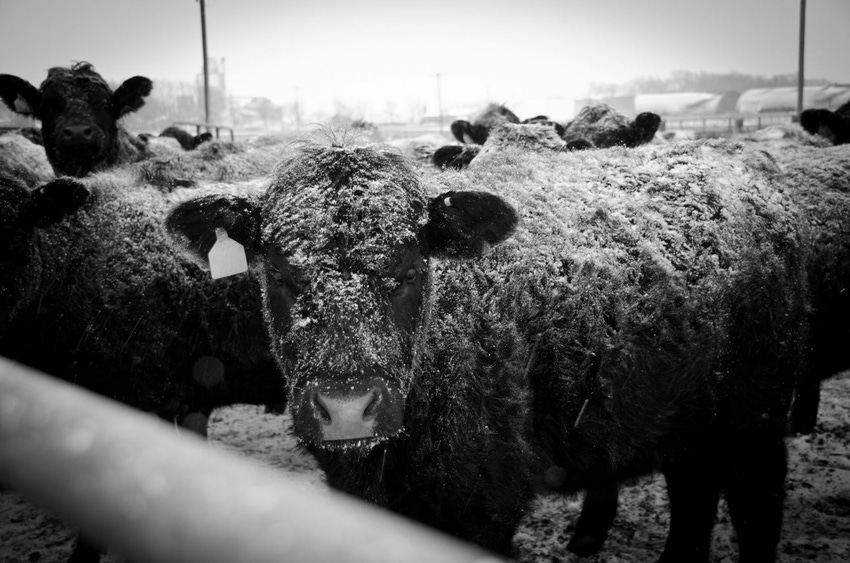The weather may put a damper on beef prices in the next couple of weeks.
February 17, 2021

FED CATTLE
Fed cattle traded steady to $1 higher compared to last week on a live basis. Prices on a live basis were primarily $113 to $114 while dressed prices were mainly $180.
The 5-area weighted average prices thru Thursday were $113.78 live, up $0.50 compared to last week and $180.07 dressed, up $0.75 from a week ago. A year ago, prices were $118.88 live and $190.26 dressed.
It would appear the cash price is attempting to catch live cattle futures, but that process is tougher than herding cats. The cash price remains $2 lower than the February live cattle contract, and there are two weeks left to close the gap. The more optimistic part of the market is April live cattle trading near $125. The ability to reach or surpass this price level is dependent on beef demand. Beef supply may play a role as well if the extremely cold temperatures persist and result in reduced cattle performance in the feedlot. It is always difficult to predict markets and weather. In this particular case, the weather further influences the market. Cattle feeders may benefit from hedging some spring and summer marketings.
BEEF CUTOUT
At midday Friday, the Choice cutout was $233.15 up $0.19 from Thursday and down $1.36 from a week ago. The Select cutout was $220.10 down $0.19 from Thursday and down $1.37 from last week. The Choice Select spread was $13.05 compared to $13.04 a week ago.
International markets play a key role in final price determination throughout the beef and cattle complex. Beef export data for December was released this week. Beef and veal exports on a quantity basis in 2020 were 2.3 percent below 2019. However, the quantity of beef and veal exported the last quarter of 2020 was 9.78 percent greater than the fourth quarter of 2019. Beef exports started 2020 strong and finished 2020 strong. It was the months at the height of the coronavirus pandemic that were soft.
The weekly beef export muscle cut data for the first five weeks of 2021 are on par with the strong start in 2020 which bodes well for exporting beef and thus price support. How-ever, the domestic beef market is the primary driver of the industry. It is important to factor in beef exports, but it is also important to remember that beef exports only account for about 11 percent of annual commercial beef production in the United States. International beef demand is important to domestic beef and cattle prices, but domestic beef demand plays a much larger role.
OUTLOOK
Based on Tennessee livestock auction data, steer prices were unevenly steady to softer compared to last week while heifer prices were also unevenly steady compared to a week ago. Slaughter cow and bull prices were steady compared to last week. Sale to sale price variability was evident this week. This variability could have been due to cattle quality, but the greater influence was most likely the weather. Precipitation events generally keep trucks and trailers from getting into fields which is a hit to calf supply on a given day or week. Alternatively, the expectation of ice and multiple snow events in a seven day period influences buyer demand. Severe weather makes it difficult to truck cattle to the farm or get cattle to the feedlot.
Even if stocker and backgrounding operations are able to get cattle to the farm, processing, treating, and caring for those animals is made more difficult by winter precipitation. Thus, the harsh weather expected locally and across much of the United States is likely what put a damper on calf and feeder cattle prices this week. The futures price expectation for feeder cattle re-mains a bright spot as the market appears to be strong in the summer and fall months for moving cattle into the feedlot.
Most feeder cattle contracts are holding near the contract highs. This does not mean they will stay there, nor does it mean the market price will increase or decrease. All it means at this point is that optimism remains in the feeder cattle market. From a production standpoint that leads to marketing, there are still several weeks before spring forage growth hits full speed. Thus, there should still be several more weeks before lightweight calf prices peak. However, the cost of holding those calves for four to eight more weeks should be considered. The same can be said for the slaughter cow market. If there are cows that need to be removed from the herd and they are in good condition then now may be a good time to sell.
Source: University of Tennessee, which is solely responsible for the information provided and is wholly owned by the source. Informa Business Media and all its subsidiaries are not responsible for any of the content contained in this information asset.
You May Also Like



